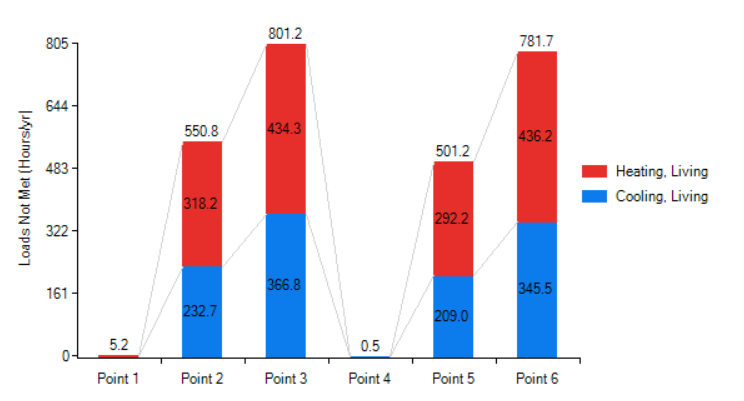Top of Slab Insulation In BEOpt Retrofit Energy Model DRAMATICALLY Increasing Loads Not Met?!!!
I am using BEOpt V2.8.0.0 to model a semi deep energy retrofit of a home my wife and I recently purchased in Taos NM (Zone 5B). First of all I want to say that the tool is fairly easy to learn and very useful in determining what energy efficiency measures make sense in terms of impact on energy use as well as cost savings. I actually have some background working for a building science firm and was certified as a HERS rater quite a few years ago so feel like I have a fairly good grasp on a lot of the concepts and strategies around efficiency and building durability. That said I was quite shocked to find when I added insulation to the top of the slab that it dramatically increased my loads not met (Hrs/year) with the same sized equipment (24,000Btuh minisplit for a single story 1200sf house). BEOpt doesn’t have a way to add “insulation” to the top of the slab so I used the Foundation Floors>Carpet input which allows you to specify the R-value of the carpet pad.
Here are the output graphs:

- Uninsulated slab loads not met 5.2 hrs/yr
- 100% top of slab R-10 insulation loads not met 550.8 hrs/yr
- 100% top of slab R-20 insulation loads not met 801.2 hrs/yr
- 4ft R-20 vertical insulation on the exterior of the slab (no top of slab insulation) loads not met 0.5 hrs/yr
- 4ft R-20 vertical insulation on the exterior of the slab and 100% top of slab R-10 insulation loads not met 501.2 hrs/yr
- 4ft R-20 vertical insulation on the exterior of the slab and 100% top of slab R-20 insulation loads not met 781.7 hrs/yr
I assume the increased loads not met have something to do with de-coupling the slab (thermal mass) from the interior space but I’d love for someone to give me a sanity check that I am modeling this correctly and, if so, does it make sense to insulate the top of the slab at all? Is using the carpet input as a way to model top of slab insulation a reasonable approach?
I ran a second case with just 40% top of slab insulation (approximately the same area that would be covered by 4ft of insulation around the inside perimeter of the house. While the model doesn’t know what the exact location of this insulation is the Loads Not Met numbers were lower but still significant and followed the same pattern of the higher the R-value of the top of slab insulation the higher the Loads Not Met hours.
Any insight into what’s going on here would be MUCH appreciated!!!





@mcsmuts you should have enough karma points now to update your post and include images.
Are the loads not met for cooling or for heating? Are you modeling with thermostat setbacks?
Also see discussion here: https://unmethours.com/question/58351...
The version of EnergyPlus that BEopt uses has a (somewhat random) bug in the foundation heat transfer model that you might be hitting. As far as we know, it's not a very common occurrence. But if you want to ensure that that isn't the cause of the issue, see https://unmethours.com/question/39577... for how to tell BEopt to use the previous foundation heat transfer model.
Thanks Aaron! Eric the loads are not met for heating or cooling. I added the output graphs to my original post. Reference my original post for what each case is. I'm pretty sure I wasn't using t-stat setbacks.
Thanks shorowit. I will try that.